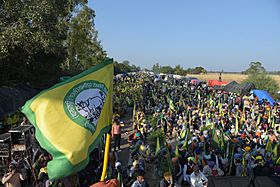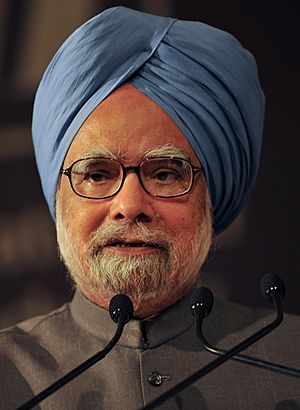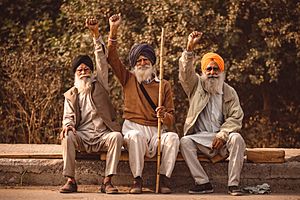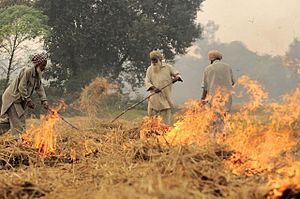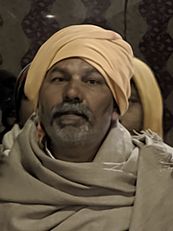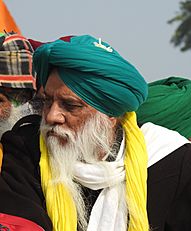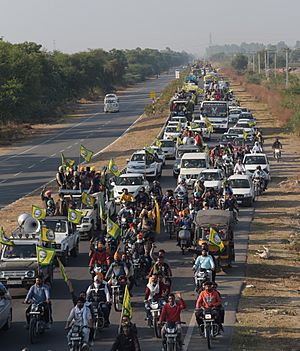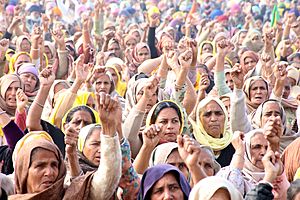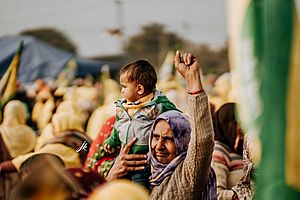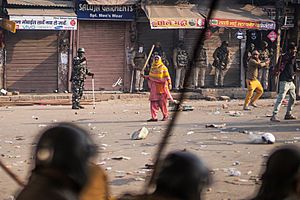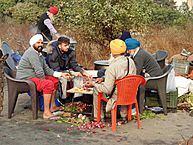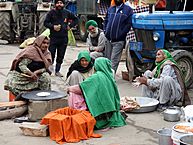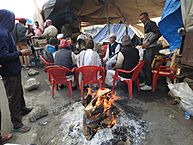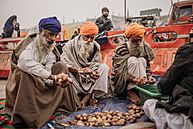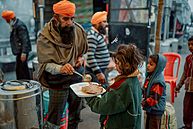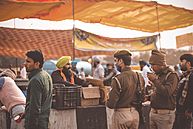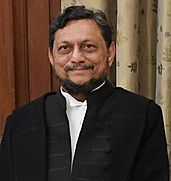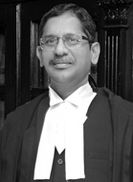2020–2021 Indian farmers' protest facts for kids
Quick facts for kids 2020–2021 Indian farmers' protest |
|||
|---|---|---|---|
| Date | 9 August 2020 – 11 December 2021 (1 year, 4 months, 2 days) |
||
| Location | |||
| Caused by | Passage of three farm related bills by the Indian parliament | ||
| Goals |
|
||
| Methods | Gherao (encirclement), dharna (sit-in), raasta roko (traffic obstruction), demonstration, counterlegislation | ||
| Resulted in | All three farm bills repealed Committee on MSP to be formed |
||
| Parties to the civil conflict | |||
|
|||
| Lead figures | |||
|
|||
| Number | |||
|
|||
| Casualties | |||
|
|||
|
|||
The 2020–2021 Indian farmers' protest was a big protest against three new laws about farming. The Parliament of India passed these laws in September 2020. Many farmer groups and politicians said these laws were "anti-farmer." They worried the laws would make farmers depend too much on big companies.
The protests were mostly peaceful. Farmers also wanted a new law to guarantee a minimum support price (MSP) for their crops. This would stop companies from setting very low prices. The Indian government said the new laws would help farmers sell their crops easily to big buyers. They also said the protests were based on wrong information.
Farmers in Punjab started local protests soon after the laws were introduced. After two months, farmer groups, mainly from Punjab and Haryana, started a movement called Dilli Chalo. This means "Let's go to Delhi." Thousands of farmers marched towards India's capital city.
The government tried to stop them using water cannons, sticks, and tear gas. Thousands of farmers gathered at Delhi's borders in November 2020. There were 11 rounds of talks between the government and farmer groups. These talks happened between October 2020 and January 2021. Most talks did not lead to an agreement.
In January 2021, the Supreme Court of India paused the new farm laws. Farmer leaders liked this decision. The laws were eventually cancelled later. Six state governments also spoke out against the laws.
The Indian government sometimes said the protests were part of a foreign plan. On January 26, 2021, India's Republic Day, thousands of farmers held a parade with tractors in Delhi. Some protesters went off the planned routes. This led to clashes with the police. Protesters reached the Red Fort and put up farmer union flags and religious flags.
On November 19, 2021, the government decided to cancel the laws. Both houses of Parliament passed the bill to cancel the laws on November 29. After this, farmer groups still asked for guaranteed minimum support prices (MSPs). They reminded the government about its goal of helping farmers earn more money. The protests officially ended on December 11, 2021.
Contents
Why Farmers Protested
India produces a lot of food, like wheat, rice, fruits, and vegetables. But even with all this food, many people in India still face hunger and poor nutrition. In 2021, India was ranked 101 out of 116 countries in the Global Hunger Index. This means hunger is a big problem in the country.
Most farmers in India have small pieces of land. About two-thirds of farms are smaller than one hectare (about 2.5 acres). This makes it hard for farmers to earn enough money. The economy in some states, like Punjab, has also grown slowly. This slow growth in farming has added to the reasons for the protest.
The Idea of a Second Green Revolution
Former Prime Minister Manmohan Singh spoke in 2004 about needing a "second green revolution." This would use modern science to improve farming. He said India needed better farming research, ways to share information with farmers, and a better system for farmers to get loans. He also mentioned that old rules from the 1930s stopped farmers from selling their crops where they could get the best prices.
In 2021, Prime Minister Modi mentioned Manmohan Singh's idea. He said his government was now working to make this "second green revolution" happen.
The Three Farm Laws
| 2020 Indian agriculture acts | |
|---|---|
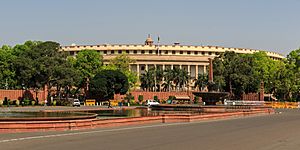
Parliament
|
|
| Parliament of India | |
| Date assented to | September 2020 |
| Repealing legislation | |
| Implementation stayed by Supreme Court on 12 January 2021. | |
| Summary | |
| The three acts provide for the creation of an ecosystem for farmers and traders, for a national framework on farming agreements and further to amend the Essential Commodities Act, 1955 | |
| Status: Repealed | |
In 2017, the government suggested new farming laws. But many states did not put these changes into practice. So, in June 2020, the central government made three temporary laws (called ordinances). These laws were about how farm products are sold, stored, and how farmers can make agreements with buyers.
These temporary laws then became bills and were passed by the Lok Sabha and Rajya Sabha in September 2020. The President of India signed them on September 28, making them official laws.
Here are the three laws:
- Farmers' Produce Trade and Commerce (Promotion and Facilitation) Act: This law allowed farmers to sell their crops anywhere, not just in special markets. It also allowed online trading. It stopped state governments from charging fees on sales outside these special markets.
- Farmers (Empowerment and Protection) Agreement on Price Assurance and Farm Services Act: This law created a way for farmers to make agreements with buyers before growing their crops. It also set up a system to solve disagreements.
- Essential Commodities (Amendment) Act: This law changed rules about storing certain food items. It said the government could only limit how much food could be stored during special times like war or famine.
What Farmers Wanted
Main Demands
The farmers had one main demand:
- Cancel the three new farm laws.
Farmers believed the laws would hurt them. They thought the laws would slowly destroy the existing market system called APMC mandis. In these mandis, farmers sell their crops and get a fair price. Farmers worried that without mandis, they would be forced to sell to big companies at very low prices. They also feared losing their connection with local middlemen who often helped them with loans and fair prices.
Other Demands
Farmers also asked for other things, including:
- Make the Minimum Support Price (MSP) a legal right. This means the government would have to guarantee a minimum price for their crops.
- Keep the old system of buying crops from farmers.
- Make sure MSP is at least 50% more than the cost of growing crops.
- Lower diesel prices for farming by 50%.
- Stop punishments and fines for stubble burning (burning crop leftovers in fields).
- Release farmers who were arrested for stubble burning.
- Cancel the Electricity Ordinance 2020.
- Withdraw all legal cases against farmer leaders.
Farmers were very firm about cancelling the laws. Even when the government offered to pause the laws for 18 months, farmers said no. They wanted the laws gone completely.
Minimum Support Price (MSP)
After the Prime Minister announced the laws would be cancelled in November 2021, farmers still pushed for a guaranteed MSP. This was their second most important demand. They reminded the government of its goal to double farmers' income by 2022. They also mentioned past recommendations from the National Commission on Farmers about MSP.
Farmer Groups Involved
Many farmer groups worked together under the Samyukt Kisan Morcha and All India Kisan Sangharsh Coordination Committee. Some of the main leaders and groups included:
- Bharatiya Kisan Union (different groups like Ugrahan, Sidhupur, Rajewal, Chaduni, Dakaunda)
- Jai Kisan Andolan
- All India Kisan Sabha
- Karnataka Rajya Raitha Sangha
- National Alliance for People's Movements
- Lok Sangharsh Morcha
- All India Kisan Khet Majdoor Sangathan
- Kissan Mazdoor Sangharsh Committee
- Rashtriya Kisan Majdoor Sangathan
- All India Kisan Mazdoor Sabha
- Krantikari Kisan Union
- ASHA-Kisan Swaraj
- Lok Sangharsh Morcha
- All India Kisan Mahasabha
- Punjab Kisan Union
- Swabhimani Shetkari Sanghatana
- Sangtin Kisan Mazdoor Sanghatan
- Jamhoori Kisan Sabha
- Kisan Sangharsh Samiti
- Terai Kisan Sabha
Even transport groups like the All India Motor Transport Congress (AIMTC) supported the farmers.
How the Protests Happened
Protests in 2020
Small protests started in Punjab in August 2020. More farmers joined after the laws were passed. On September 25, 2020, farmer groups called for a Bharat Bandh (nation-wide shutdown). Protests were biggest in Punjab, Haryana, and Western Uttar Pradesh. But they also happened in other states.
Train services in Punjab were stopped for over two months because of the protests. Farmers then marched to Delhi. They also criticized the news media for showing their protest in a wrong way. From December 12, farmers took over highway toll plazas in Haryana. They allowed cars to pass for free. Some farmers even used bullock-carts to protest.
Stopping Trains and Marching to Delhi
On September 24, 2020, farmers started a "Rail roko" (stop the trains) campaign. This affected train services in Punjab. Farmers continued this campaign into October. Some groups stopped it later because there was a shortage of fertilizers and other goods.
When state governments didn't help, farmers decided to march to Delhi. On November 25, police met protesters at Delhi's borders. Police used tear gas, water cannons, and barricades to stop them. At least three farmers were hurt. A young man became famous for jumping onto a police water cannon and turning it off. He was later charged with attempted murder.
Millions of people across India went on a 24-hour strike on November 26 to support the farmers. By early December, about 150,000 to 300,000 farmers were blocking roads around Delhi. Farmers wanted immediate talks, but the government set a date for December 3. The farmers wanted to protest in central Delhi, but the government asked them to go to a special protest site.
Farmers burned effigies (dolls) of the Prime Minister and company leaders. Some famous people returned their awards to the government. On December 9, farmer groups rejected the government's offers for changes in the laws. They wanted the laws cancelled. On January 26, 2021, Republic Day, thousands protested in Delhi. They held tractor rallies and entered the historic Red Fort.
Blocking Roads
Protesters blocked many roads and borders around Delhi. These included the Singhu, Tikri, and Ghazipur borders. In early 2021, police put up metal barricades, cement walls, and iron nails on roads leading to these borders. This was to stop vehicles and people from entering Delhi.
Counter-Protests
Some farmer groups, like the Shetkari Sanghatana in Maharashtra, supported the new laws. They believed that the market should decide crop prices. They said that minimum support prices actually made farmers weaker.
Some groups also marched to Delhi to support the farm laws. However, some of these groups were linked to the ruling political party and not directly to farmers. On January 28, 2021, people living near the protest sites also protested. They wanted the farmers to leave because the blockades affected their daily lives.
Protests in 2021
Republic Day Tractor Parade
On January 26, 2021, Republic Day, tens of thousands of farmers held a tractor parade in Delhi. They drove in long lines of tractors, rode horses, or marched on foot. The parade started from Singhu, Tikri, and Ghazipur borders. Police had approved specific routes.
However, some farmers went off the planned routes and marched towards the city center. They broke through barricades. The Delhi Police used tear gas and hit protesters with sticks. Several metro stations were closed, and mobile internet was stopped.
Protesters entered the Red Fort in Delhi. Some put up farmer union flags and religious flags on the fort's flagpole. Clashes between police and farmers also damaged parts of the fort. Many police officers and farmers were hurt. Police vehicles were damaged. Internet services were stopped in many parts of Delhi.
After the Republic Day parade, police built strong barricades and dug trenches at the protest sites. This made it harder for people to move around. At the Ghazipur border, farmer leaders said that water and electricity were cut off.
The Delhi Police filed many criminal cases and arrested several people. Over 300 police officers were hurt. Some farmer groups decided to leave the protest after the violence. One person died when his tractor overturned during the protest.
Impact of COVID-19
Fewer protesters were at the sites around Delhi during the second wave of the COVID-19 pandemic. This was also because it was harvest season.
Later Protests
On February 3, farmer leaders warned they would increase their protest if the laws were not cancelled. On March 21, farmers planned to protest in Bengaluru, saying they would "turn Bengaluru into Delhi." As of March 21, about 40,000 protesters were still at the Singhu and Tikri borders.
Farmer groups planned for 200 farmers to protest outside the Parliament every day starting July 22, 2021. On September 5, over 500,000 farmers attended a big rally in Muzaffarnagar, Uttar Pradesh.
On September 27, farmer groups called for another Bharat Bandh. This shutdown had a limited effect across the country. A protest on October 3, 2021, in Lakhimpur Kheri, led to several deaths.
In November 2021, farmers stopped a movie from being shown in five cinemas in Hoshiarpur. They were upset that the actor Akshay Kumar had not supported them. A protest on November 5 turned violent, and a politician's car window was broken.
A tractor march to Parliament planned for November 29, 2021, was cancelled. The farmer groups made it clear that the protest was not over yet.
How the Protests Were Organized
Food and Meals
Many langars (community kitchens) and temporary kitchens were set up by farmer groups and NGOs. They provided free food to tens of thousands of farmers at the protest camps around Delhi. These kitchens worked all day and night. They offered hot meals like pizzas, lentils, vegetables, roti (Indian bread), buttermilk, and tea.
News reports showed how these langars used machines to make 1000 rotis an hour. Some reports also showed farmers eating pizzas, which led to some people making fun of the protest. Other reports highlighted farmers eating dried fruits and nuts. Organizations like Delhi Sikh Gurdwara Committee, Khalsa Aid, and others helped with food. A temporary school was also set up at the camp for children who could not go to school.
Shelter and Supplies
Besides food, farmers at the camps received help from local and international groups. They got tents, solar-powered mobile charging points, air conditioners, televisions, laundry services, and even a library. Medical stalls and dental camps were also set up. Some camps even had foot massage chairs for protesters.
Safety and Monitoring
At the Singhu border, farmers put up eight CCTV cameras. This helped them watch the protest site. They wanted to keep records of what was happening. This way, they could show that they were not involved in any bad activities.
Healthcare
Doctor Swaiman Singh, an Indian-American doctor, came to help at the protest sites. He had planned to stay for a few weeks but ended up staying for months. His non-government organization provided a team of doctors. Volunteers also helped by bringing supplies to the free medical camps.
Deaths During the Protests
Many farmers died during the protests. On December 20, 2020, 41 farmers had died. By January 8, 2021, this number had gone over 120. As of July 10, 2021, over 537 protesters had died. In October and November 2021, a farmer leader said about 750 protesters had died.
Deaths in 2020
The first farmer to die was Dhanna Singh, aged 45. He died on November 26, 2020, while trying to get his tractor past a police roadblock. He was on his way to join the protest.
By December 20, 2020, 41 farmers had died since September 15. Most were from Punjab. Seven died from cold and heart attacks at the Tikri border, and six at the Singhu border.
Deaths in 2021
On January 1, 2021, Galtan Singh, 57, died at the Ghazipur border. He was the first farmer death reported at the UP border. On January 2, three more farmers died at the Tikri and Singhu borders.
Navreet Singh, 25, died on January 26, 2021, during the Republic Day tractor rally. He was the only person who died during that rally.
On October 3, during the Lakhimpur Kheri massacre, eight farmers were killed. This happened during a protest in Uttar Pradesh.
Remembering Those Who Died
On December 20, 2020, farmers held a "Shradhanjali Diwas" (Homage and Remembrance Day). They honored the 41 farmers who had died. Events were held at the protest camps and in villages across the country.
On January 4, 2021, during talks between the government and farmer leaders, everyone observed a two-minute silence for the farmers who had died.
Supreme Court's Role
The Supreme Court of India received many requests to remove the protesting farmers from blocking roads. The Supreme Court said it would set up a group to help with talks. On December 17, the Supreme Court said that farmers had a right to protest peacefully. But they also said that talking and reaching a solution was important.
Farmers said they would not listen to the courts if told to stop protesting. They also said that just pausing the laws was not a solution.
On January 11, 2021, the Chief Justice of India said the court was "extremely disappointed" with how the government was handling the protests. He asked the government if they would pause the laws, or the court would do it. The court also said they had not received any proof that the laws were good for farmers.
Supreme Court Pauses Laws and Forms Committee
On January 12, 2021, the Supreme Court of India officially paused the farm laws. They also created a committee to listen to the farmers' problems. The committee included farming experts. One member, Bhupinder Singh Mann, later left the committee to support the farmers.
The committee continued its work and met with many farmer groups. They submitted their report to the Supreme Court on March 19, 2021. The report was later made public on March 21, 2022, after the laws were cancelled.
States Make Their Own Laws
The state assembly of Punjab passed four bills to go against the central government's three farm laws. After Punjab, Rajasthan and Chhattisgarh also tried to pass their own bills. However, the governors of these states did not sign these bills into law.
Effects of the Protests
As farmers believed that big companies like Reliance Jio were benefiting from the new laws, they started to switch to other mobile networks. Some Reliance Jio mobile towers were damaged in Punjab in December 2020. The Chief Minister of Punjab asked farmers to stop damaging the towers.
On November 19, 2021, Prime Minister Narendra Modi announced that his government would cancel the three farm laws. He said his government had tried to explain the benefits to farmers but had failed. He made this announcement on the special day of Gurupurab. Many people thought this decision was made because of upcoming state elections in Punjab and Uttar Pradesh. A farmer leader said the protests would only stop once the laws were officially cancelled.
On November 29, both houses of the Indian Parliament passed the bill to cancel the farm laws. The President of India signed the bill two days later. Later, in March 2022, a special group set up by the Supreme Court found that most farmer organizations (86%) had actually supported the farm laws.
Songs and Slogans
Many songs were released by singers and songwriters to describe the protest and show support. These songs helped bring people together. A song called "Ek Din" by Bohemia, The Game, and Karan Aujla even featured clips from the protest.
Some popular slogans used during the protests included:
- No farmers, no food
- India is Killing its Farmers
- Recall the farm bills
- Dharti Mata Ki Jai (Hail Mother Earth)
- Narendra Modi Kisan Virodhi (Narendra Modi farmer enemy)
- Inquilab Zindabad (Long live the revolution)
- Chahe Kuch Bhi Karlo Hum Badhte Jaenge (No matter what you do, we will keep moving forward)
Images for kids
See Also
 In Spanish: Paro agrario de India de 2020-2021 para niños
In Spanish: Paro agrario de India de 2020-2021 para niños
- Agrarian distress
- National Commission on Farmers
- Neoliberalism
- Satyagraha


